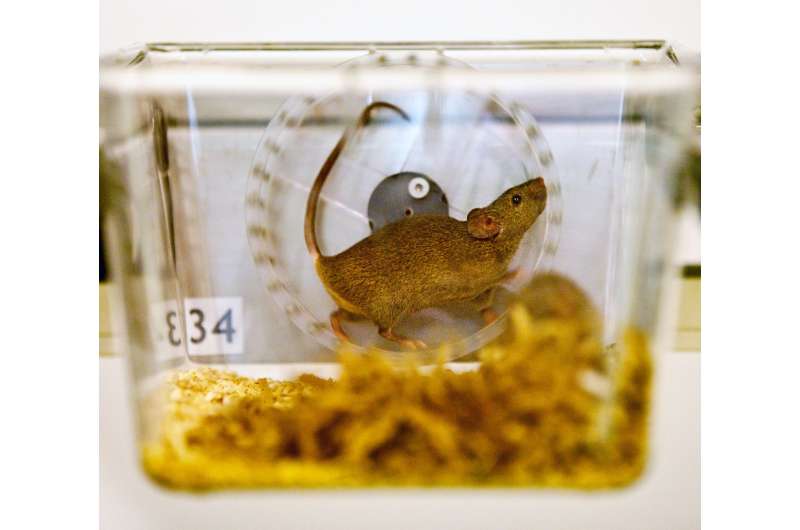A mouse demonstrating voluntary wheel running (VWR) Credit: Kaiser/MHH
The amount of time a mouse spends running on the wheel provides an accurate and objective measure of the discomfort induced by research procedures, according to a new study publishing October 18 in the open-access journal PLOS Biology by André Bleich and colleagues from the Hannover Medical School in Germany. The finding may improve care and reduce suffering for animal subjects, a key goal of statutory guidelines governing animal welfare in biomedical research.
A widely adopted set of guidelines called the 3Rs (replace, reduce, and refine) urges researchers to replace animals where possible, to reduce their numbers where not, and to refine methods to minimize pain and suffering. Objective, non-invasive means of assessing severity are scarce, which led the authors to ask whether voluntary wheel running (VWR) in mice might provide such a measure, based on previous work showing its relation to stress response, mood, and reward, and its distinction from other forms of general motor activity.
To test this, mice were fed varying amounts of the chemical dextran sulphate to induce experimental colitis of varying severity, and were assessed for the amount of time spent in VWR, and with a standard clinical scoring tool. VWR better correlated with colitis severity as determined by multiple measures, including weight loss. VWR was also better at monitoring severity of other distressing treatments, including drawing blood and physical restraint. Mathematical clustering analysis allowed the assignment of discrete severity levels (0, 1, or 2) to changes in VWR, which may simplify statistical analysis in future trials. The authors have made their severity assessment tool freely available online.
"Assessment of severity animals experience during experimentation is elementary from an ethical, legal and scientific point of view," Bleich said. "However, evidence-based objective methods and gradable parameters are scarce. The presented work indicates that the use of behavioral phenotyping and mathematical clustering helps to overcome this situation."
The numerical correlation between VWR and colitis severity obtained in this study will not be directly applicable to severity in other model disease systems, the authors note, but it seems likely that generating a disease-specific VWR-based severity scale in many other models will be straightforward. "The general method presented here may have wide applicability in biomedical research," Bleich said, "and may provide researchers a better way to implement the 3R principles into their studies."
More information: Häger C, Keubler LM, Talbot SR, Biernot S, Weegh N, Buchheister S, et al. (2018) Running in the wheel: Defining individual severity levels in mice. PLoS Biol 16(10): e2006159. DOI: 10.1371/journal.pbio.2006159
Journal information: PLoS Biology
Provided by Public Library of Science





















